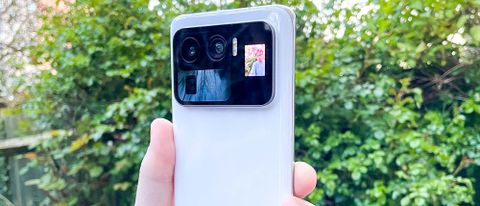Tom's Guide Verdict
Although Xiaomi has taken the Mi 11 to the max with this Ultra handset's excellent photography, extra display and rapid charging, we need to know the price before we understand how good (or bad) it truly is.
Pros
- +
Beautiful display
- +
Outstanding cameras
- +
67W wired or wireless charging
Cons
- -
No U.S. availability
- -
More expensive than the standard Mi 11
- -
Poor battery life
Why you can trust Tom's Guide
As far as “ultra” phones go, the Xiaomi Mi 11 Ultra is hard to comprehend. Its monolithic design, enormous cameras, stunning display and secondary rear display give it an unmistakable look — one that shows Xiaomi means business when it sets its sights on taking down its Samsung, OnePlus and Apple rivals.
Starting price: TBA
Display: 6.81-inch QHD AMOLED (3200 x 1440)
Refresh rate: Adaptive, 30Hz/60Hz/90Hz/120Hz
Rear display: 1.1-inch AMOLED (126 x 294)
Rear cameras: 50MP main (f/1.95), 48MP ultrawide (f/2.2), 48MP telephoto (5x optical zoom, 120x max zoom, f/4.1)
Front camera: 20MP (f/2.2)
Chipset: Snapdragon 888
RAM: 12GB
Storage: 256GB
Battery: 5,000mAh
Charging: 67W wired, 67W wireless, 10W reverse wireless
Operating system: Android 11 with MIUI 12
Size: 6.46 x 2.93 x 0.33 inches (164.3 x 74.6 x 8.38mm)
Weight: 8.25 ounces (234g)
Water/dust resistance: IP68
Those specs aren’t just for ticking boxes either. All of them work as well as you’d expect, with a few, such as the QHD resolution, 120Hz panel, zippy 67W charging or the telephoto camera, offering class-leading performance.
However, this model’s ultimate fate rests on how much Xiaomi wants to charge for it. The basic Xiaomi Mi 11 is already a great value, and uses several identical parts to the Mi 11 Ultra, so arguably the Ultra could be too expensive for its own good. However, with careful pricing, the Xiaomi Mi 11 Ultra could make itself the most accessible ultimate smartphone around.
Xiaomi Mi 11 Ultra review: Price and release date
We know that the Xiaomi Mi 11 Ultra will be coming to the U.K, though it will skip the U.S., given Xiaomi’s ongoing dispute with the U.S. government over alleged risks to national security.
Xiaomi has yet to name a date and price for the U.K. version of the Mi 11 Ultra. Given the basic Xiaomi Mi 11 costs £749, just a little less than the £769 Galaxy S21 or £829 OnePlus 9 Pro, it follows that the Ultra version would cost well over £1,000, perhaps similar to the £1,149 Samsung Galaxy S21 Ultra and £1,099 iPhone 12 Pro Max.
However, the price of the Ultra in India, the only market with an announced price so far, gives us hope. At 70,000 rupees, the Mi 11 Ultra costs less than a Galaxy S21 Plus, and the same as a OnePlus 9 Pro. We can't account for how regional differences will affect that price when it comes to the U.K., but if Xiaomi can afford to sell the Mi 11 Ultra for less than £1,000,, it would undercut its rivals significantly, and become an incredible bargain for the hardware it offers, even accounting for the already cheap Mi 11.
Xiaomi Mi 11 Ultra review: Design
You might mistake the Xiaomi Mi 11 Ultra for the basic Mi 11 from the front. The curved punch-hole display looks smart, but it's indistinct from both other Mi 11 models and other Android phones.
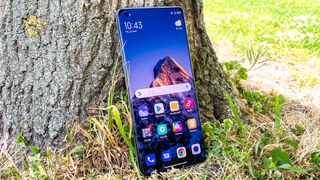
Flip the phone over, and everything changes. You’re immediately drawn to the huge rectangular camera bump that stretches almost the entire width of the phone, and the top third of the back. The three large camera openings look foreboding, and that’s not to mention the secondary rear display sat to their right.
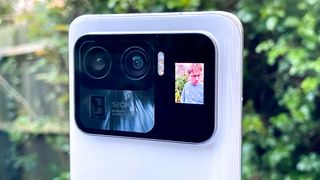
The Xiaomi Mi 11 Ultra comes with a tough ceramic body, in either black or white. I prefer the white version since it helps the camera bumps stand out even more, but both colors look elegant and the Mi 11 Ultra should shrug off scratches better than a glass- or plastic-backed phone.


Both the front and back of the Xiaomi Mi 11 Ultra curve into the metal side rails, which makes it fit surprisingly well into your hand and comfortable to use even with just one hand. You’ll notice the weight of this phone the moment you pick it up, though.
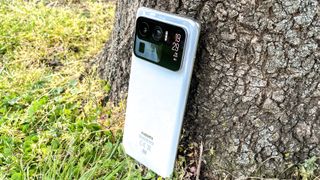
At more than 8 ounces, the Mi 11 Ultra is heavier than the Galaxy S21 Ultra or the iPhone 12 Pro Max, though I didn’t find it tough to use over long periods. What did get a little annoying however was how easy it is to snag the Mi 11 Ultra’s large camera bump on a jeans pocket, stopping you from putting the phone away as effortlessly as you’re likely used to.
Xiaomi Mi 11 Ultra review: Display
Xiaomi has equipped the Mi 11 Ultra with an exquisite display. The 6.81-inch AMOLED panel comes complete with a QHD resolution and a 120HZ maximum refresh rate and has a subtle curve on all four edges to make it easier to hold.
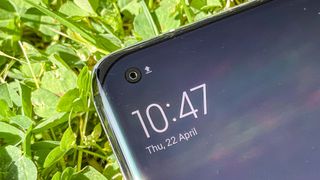
If you prioritize battery life over refresh rate and resolution, Xiaomi has made it easy to tone down these settings. You can set the display to an FHD resolution instead, and the 120Hz resolution can dynamically scale down to 90Hz, 60Hz or 30Hz if the content you’re looking at won’t be hurt by a lower refresh rate.

Watching the Shang Chi and the Legend of the Ten Rings trailer to try out the Mi 11 Ultra’s display, I was not disappointed. The floating water effects, neon lights and burning hot blade that all appear at various points in the trailer all looked fantastic, but as I watched the teaser for the next installment of the MCU, I had a nagging thought — the Mi 11 Ultra’s display is a bit underwhelming. It’s the exact same as the one on the Mi 11, which is far cheaper to buy.
That means despite the display being one of the Xiaomi Mi 11 Ultra’s best features, the screen is not a good enough reason to pay up for this phone on its own.
Xiaomi Mi 11 Ultra review: Rear display
The displays don’t stop with the Xiaomi Mi 11 Ultra’s 6.81-inch main display. The back of the phone features a secondary 1.1-inch panel, about the size of a fitness band’s screen. You’ll find the secondary display within the camera bump, and it’s one of the Mi 11 Ultra’s signature features. Unfortunately, the display offers surprisingly limited functionality.
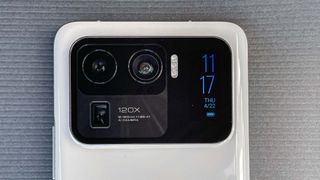
With the phone locked, the rear panel acts as a miniature always-on display when you tap it, showing you the time, date, battery level and whether you have notifications. When the phone’s open, you can use the rear screen as a preview window for the rear cameras, allowing your subjects to see themselves before you hit the shutter button. Unfortunately, you can only enable this when in normal photo mode, not when taking portrait mode shots.
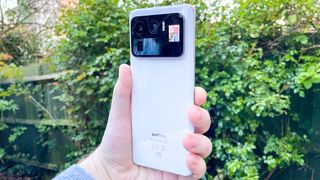
Both of these are practical applications for a secondary display, putting us in mind of how the foldable Samsung Galaxy Z Flip or Motorola Razr use their mini external displays. I can’t say I’m convinced this is going to be the next hot trend in smartphone design though — it feels too light on features to make it worth adding a second screen. Plus the Xiaomi Mi 11 Ultra’s rear panel is very dim. Any above-average amount of light makes it impossible to read, particularly from extreme angles.
Xiaomi Mi 11 Ultra review: Cameras
The Mi 11 Ultra aims for camera quality over quantity, offering just three rear sensors. The ones that are there feature impressive specs. The main camera uses a 50MP sensor, with the ultrawide and telephoto cameras both featuring 48MP sensors. The telephoto camera, as text on the back of the phone reminds you, is capable of 120x zoom, although you’ll be better off sticking to its 5x optical or 10x hybrid zoom levels instead.
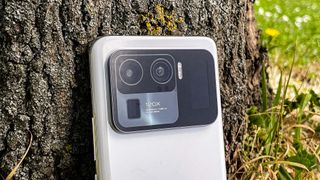
The Mi 11 Ultra’s front camera has a 20MP sensor, but it almost doesn’t need to be there. The secondary display allows all the rear cameras to be practically used for selfies.
To put the Mi 11 Ultra through its paces, I compared it with shots taken by the iPhone 12 Pro, one of the best camera phones around. In this first comparison of the phones’ main cameras, I took a shot of the London Eye that turns out to be a narrow win for the iPhone. The Mi 11 Ultra’s image is oddly dark, while the iPhone manages to capture the sky just as well as it recreates the detail of the Eye’s structure.
In a slightly darker environment however, the Mi 11 pulls ahead. See how the colors of the leaves and grass in the sunken square of Paddington Central are much richer than that of the iPhone’s shot, plus how the Mi 11 Ultra still manages to capture the sky without the light blowing out the color.
However when it’s a proper night mode shot, I think the iPhone has the edge. The Mi 11 Ultra’s image of the Euston Station war memorial is brighter but fails to capture the color of the sky or the street lamp light cast on the stonework in quite the same way as the iPhone.
Switching to the ultrawide sensor, the Mi 11 Ultra’s larger sensor has produced a brighter image that also retains the detail of the light playing on the metal installation and concrete bridge above. However it is more obviously distorted than the iPhone’s image, which looks all right overall.
The Mi 11 Ultra’s strongest photos come from its telephoto lens. Xiaomi’s phone has one of the largest, highest resolution sensors combined with a powerful periscope zoom, so it’s unsurprising to see that it takes a clearer image at 2x zoom than the iPhone’s 2x optical zoom lens does.
Even increasing to 10x zoom, the Mi 11 Ultra still keeps the Elizabeth Tower, a.k.a. Big Ben, looking sharp, even from the other side of the River Thames.

The maximum 120x zoom is impressive, as you can see below. However it’s not a good quality image, and I found it hard to aim without a tripod due to the subtle movements of your hand causing the view to bob and weave.

The last test is to look at how the selfie camera performs. We see the Mi 11 Ultra’s image is not as saturated, and has a more subtle bokeh effect in the background. While I prefer how I look in the shot from the Xiaomi phone, the iPhone’s done a better job with the background.
I also tried taking a selfie using the rear display and the Xiaomi’s main camera. This was fairly easy to manage on the Mi 11 Ultra, and resulted in the highest resolution selfie I’ve ever taken.
It’s this kind of shot, along with the telephoto camera, that sets the Mi 11 Ultra apart from all other flagship phones. Even the images where I picked the iPhone version as the better one, there was nothing actually wrong with the shot from the Xiaomi. It seems safe to say the Mi 11 Ultra has earned the right to its colossal camera bump.
Xiaomi Mi 11 Ultra review: Performance
Xiaomi has shoehorned a Snapdragon 888, 12GB RAM and 256GB storage into the Mi 11 Ultra. There aren’t many phones with better specs, so you can rest assured the Mi 11 Ultra will handle any app or game you want to run on it.
On the Geekbench 5 app that measures general performance, the Mi 11 Ultra posted a single-core result of 1,136 points, and a multicore score of 3,724. That’s slightly ahead of the OnePlus 9 Pro (1,126 and 3,685) and the Samsung Galaxy S21 Ultra (1,123 and 3,440), but still a ways off the iPhone 12 Pro Max (1,603 and 4,111) and its all-conquering A14 Bionic chipset.
Moving to the 3DMark graphic benchmark and its Wild Life Unlimited test, and the Mi 11 Ultra scored 5,617 points and managed an average of 33.8 frames per second. Comparing to the same phones as before, the OnePlus 9 Pro and S21 Ultra beat it (5,755 and 34.5fps, 5,739 and 34.37fps) as does the iPhone 12 Pro Max (9,113, 54fps).
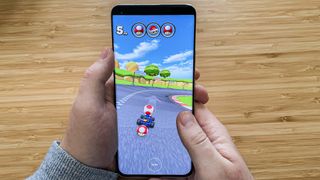
I tested the Xiaomi Mi 11 Ultra’s performance for myself by playing Mario Kart Tour, and I didn’t notice the performance gap between this Xiaomi device and the other phones. The game plays excellently, and Xiaomi’s Game Turbo software streamlines the phone’s performance to make sure you get the best from the device, and can play without being disturbed.
Xiaomi Mi 11 Ultra review: Battery and charging
The Xiaomi Mi 11 Ultra is fitted with a 5,000 mAh battery, a hefty power pack for most phones. The Mi 11 Ultra’s battery is unique in that it uses nano silicon oxide, which allows it to stuff the same capacity into a smaller footprint compared to a traditional lithium-ion smartphone battery.
I drained the battery with my informal YouTube binge-watching test, and after 6 hours of non-stop video, the Mi 11 Ultra had gone from 100% charge to 64% charge. As you'd expect from a phone with two screens, the main one being among the best currently on offer on any phone, the battery life takes a severe knock. Even with the phone sat on my desk with the always-on display enabled,
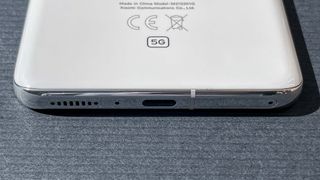
Impressively, you can charge at the same 67W speed with a wired or wireless connection, assuming you have the right plug and Xiaomi's sold-separately charging stand. While you will get the wired charging block in the Mi 11’s box, sadly Xiaomi was unable to provide us with either of these for testing. Its own figures claim that charging with one of these fills the phone 100% full in only 36 minutes. That beats both the Galaxy S21 Ultra and the iPhone 12 Pro, neither of which come bundled with chargers. However, the latest OnePlus 9 flagships can pull off the same feat while taking a few minutes less, due to their dual-cell 4,500 mAh battery designs.
Xiaomi Mi 11 Ultra review: Software
The MIUI 12 spin on Android 11 is a good one, so we’re glad Xiaomi kept this interface for the Mi 11 Ultra. Xiaomi has successfully balanced the straightforward stock Android experience with its own exclusive features, such as floating windows, always-on displays, and an attractive look with nicely animated transitions.
The only new feature worth mentioning is the options menu for the rear display, found within the special features section on the Xiaomi Mi 11 Ultra. It allows you to pick whether the display shows a clock, signature or image, what color it uses, which notifications show, if you want to turn it on with a double-tap and how long it stays on for before disappearing. You can also disable it completely, which seems like a waste of one of the phone’s biggest features.
Xiaomi Mi 11 Ultra review: Verdict
The Xiaomi Mi 11 Ultra is a powerful phone that’s either going to be the smartphone bargain of the year or repakcage what the Xiaomi Mi 11 already offers. Because of how generous Xiaomi was with the basic Mi 11, which shares the same main display and chipset while still offering competent photography, the Mi 11 Ultra offers less additional value to the Mi 11 compared to what a Galaxy S21 Ultra offers on top of a base Galaxy S21, for example. Therefore, Xiaomi will make or break the Mi 11 Ultra based on how much it charges for the new phone.
This is a moot point for U.S. users, who still have to look at other phones by default, such as the Samsung Galaxy S21 Ultra or OnePlus 9 Pro. U.K. users however could find themselves in one of two worlds. If Xiaomi sells the Mi 11 Ultra for around the £1,000 mark like the Indian retail price suggests, then we will be offered an Android phone with iPhone-rivalling photo quality, two displays and some of the fastest charging speeds around for the price of a mid-level Samsung flagship. It would be hard to deny the Mi 11 Ultra a spot on our best camera phones or overall best phones guides if this comes to pass.
However if Xiaomi follows the example of the S21 Ultra and iPhone 12 Pro Max and charges around £1,200, then the Mi 11 Ultra becomes an overgrown Mi 11 that doesn’'t offer the extra £400 to £500 of value. In this case, it's still a great phone, but one that gets outshone by the nearly identical Xiaomi Mi 11.
If you're convinced of the utility of the extra display, the 67W charging and the power of the rear cameras, then buy a Mi 11 Ultra, you won't find these features replicated anywhere else any time soon. Most users in the market for a premium phone might want to wait though, in case we live in the timeline where Xiaomi is about to drop the best value flagship phone of the year.

Richard is based in London, covering news, reviews and how-tos for phones, tablets, gaming, and whatever else people need advice on. Following on from his MA in Magazine Journalism at the University of Sheffield, he's also written for WIRED U.K., The Register and Creative Bloq. When not at work, he's likely thinking about how to brew the perfect cup of specialty coffee.
Most Popular


